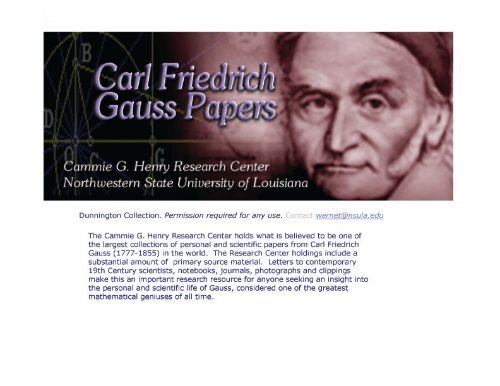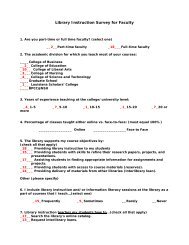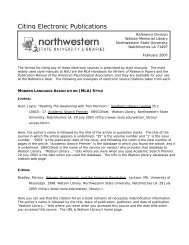Carl Friedrich Gauss Papers - Library - Northwestern State University
Carl Friedrich Gauss Papers - Library - Northwestern State University
Carl Friedrich Gauss Papers - Library - Northwestern State University
Create successful ePaper yourself
Turn your PDF publications into a flip-book with our unique Google optimized e-Paper software.
Titan of Science has recently been republished with<br />
additional material by Jeremy Gray and is available<br />
at the Mathematical Society of America<br />
ISBN: 0883855380<br />
G. Waldo Dunnington, who taught German<br />
at <strong>Northwestern</strong> <strong>State</strong> <strong>University</strong> from 1946<br />
until his retirement in 1969, collected these<br />
resources over a thirty year period.<br />
Dunnington wrote <strong>Carl</strong> <strong>Friedrich</strong> <strong>Gauss</strong>,<br />
Titan of Science, the first complete<br />
biography on the scientific genius in 1955.<br />
Dunnington also wrote an Encyclopedia<br />
Britannica article on <strong>Gauss</strong>. He<br />
bequeathed his entire collection to the<br />
Cammie Henry Research Center at<br />
<strong>Northwestern</strong>.
<strong>Gauss</strong> and Physicist Wilhelm Weber collaborated in<br />
1833 to produce the electro-magnetic telegraph.<br />
They devised an alphabet and could transmit<br />
accurate messages of up to eight words a minute.<br />
The two men formulated fundamental laws and<br />
theories of magnetism.<br />
<strong>Gauss</strong> was appointed director of the<br />
<strong>University</strong> of Göttingen observatory and<br />
Professor. Among his other scientific<br />
triumphs, <strong>Gauss</strong> devised a method for the<br />
complete determination of the elements of<br />
a planet’s orbit from three observations.<br />
<strong>Gauss</strong> and his achievements are<br />
commemorated in currency, stamps and<br />
monuments across Germany. The<br />
Research Center holds many examples of<br />
these.
After his death, a study of <strong>Gauss</strong>' brain revealed the<br />
weight to be 1492 grams with a cerebral area equal<br />
to 219,588 square centimeters, a size that could<br />
account for his genius<br />
Links to more material on <strong>Gauss</strong>:<br />
Dunnington's Encyclopedia Article<br />
Description of Dunnington Collection at the Research<br />
Center<br />
<strong>Gauss</strong>-Society, Göttingen<br />
<strong>Gauss</strong>, a Biography<br />
Gauß site (German)<br />
Göttingen, the home of <strong>Gauss</strong>, and site of<br />
much of his research.
References for <strong>Gauss</strong><br />
Nelly Cung's compilation of <strong>Gauss</strong> material<br />
http://www.gausschildren.org This web site gathers<br />
together information about the descendants of <strong>Carl</strong> <strong>Friedrich</strong><br />
<strong>Gauss</strong><br />
Contact Information:<br />
Cammie G. Henry Research Center,<br />
<strong>Northwestern</strong> <strong>State</strong> <strong>University</strong> of Louisiana Libraries<br />
Natchitoches, LA 71497<br />
(318) 357-4585<br />
Email: wernet@nsula.edu
From the Dunnington Collection at the Cammie G. Henry Research Center, Watson<br />
Memorial <strong>Library</strong>, <strong>Northwestern</strong> <strong>State</strong> <strong>University</strong> of Louisiana<br />
(JOHANN) CARL FRIEDRICH GAUSS (1777-1855)<br />
from Encyclopaedia Britannica<br />
Copyright 1960<br />
by G. WALDO DUNNINGTON<br />
German mathematician and scientist, to whom history has accorded a place with<br />
Archimedes and Newton as one of the three greatest mathematicians of all time, is<br />
frequently called the founder of modern mathematics. The importance of his work in<br />
astronomy and physics is scarcely less than that in mathematics. His full stature<br />
became known only in the 20th century since many of his discoveries were published<br />
long after his death. During his lifetime he published 155 titles.<br />
He was born at Brunswick, April 30, 1777, and died at Göttingen, Feb. 23, 1855.<br />
<strong>Gauss</strong> was of Nether-Saxon peasant origin. Many anecdotes refer to his prodigious<br />
precocity, particularly in mental computation. As an old man he said facetiously that<br />
he could count before he could talk. In elementary school he soon impressed his<br />
teacher, who is said to have convinced <strong>Gauss</strong>’s father that the son should not learn a<br />
trade, but follow a learned profession. in secondary school, after 1788, he rapidly
distinguished himself in ancient languages and mathematics.<br />
At the age of 14 <strong>Gauss</strong> was presented to the Duke of Brunswick at court, where he<br />
was permitted to exhibit his computing skill. On this occasion he was given several<br />
mathematical textbooks. Until his death in 1806 the duke generously supported <strong>Gauss</strong>.<br />
<strong>Gauss</strong> conceived almost all his fundamental mathematical discoveries between the<br />
ages of 14 and 17.<br />
In 1791 he gave attention to the arithmetico-geometric mean. <strong>Gauss</strong> now manifested<br />
his outstanding trait of critical analysis and thus began to do creative work. He called<br />
this acuteness the rigor antiquus. In 1792, the year that he entered the three-year<br />
Collegium Carolinum in Brunswick, his interests led him to question the foundations<br />
of geometry.<br />
<strong>Gauss</strong> shunned controversy, and though a pioneer he published nothing on non-<br />
Euclidean geometry. In 1793—94 he did intensive research in number theory,<br />
especially on the frequency of primes. He made this study his life’s passion and is<br />
regarded as its modern founder. <strong>Gauss</strong> obtained a copy of Newton’s Principia in 1794<br />
in that year he discovered the method of least squares.<br />
In 1795 he completed important research on quadratic residues. <strong>Gauss</strong> studied at the<br />
<strong>University</strong> of Göttingen from 1795 to 1798; there he had access to the works of<br />
Fermat, Euler, Lagrange and Legendre, the masters in his field. He soon realized that<br />
he too was a master and decided to write a book on the theory of numbers. It appeared<br />
in 1801 under the title Disquisitiones arithmeticae; this classic work, establishing the<br />
theories of cyclotomy and arithmetical forms, usually is held to be <strong>Gauss</strong>’s greatest<br />
accomplishment.<br />
In studying the roots of the equation xp= I, <strong>Gauss</strong> discovered on March 30, 1796. that<br />
the regular heptadecagon (polygon with 17 sides) is inscriptible in a circle, using only<br />
compasses and straightedge—the first such discovery in Euclidean construction in<br />
over 2,000 years. <strong>Gauss</strong> had been undecided whether to make mathematics or<br />
philology his life work; he now resolved to devote his life to the former.
In late 1796 <strong>Gauss</strong> was busy with research in infinitesimal calculus and algebra and<br />
began an investigation of the lemniscate functions; he found a proof of Lagrange’s<br />
theorem (reversion formula) and discovered the connection between the elliptic<br />
quadrant and the arithmetico-geometric mean, as well as its connection with the<br />
power series whose exponents are squares. The theories of elliptic functions and of<br />
linear differential equations were rediscovered some decades after <strong>Gauss</strong> had<br />
developed them for himself; he discovered double periodicity and operated with the<br />
general theta functions.<br />
His interest then turned to<br />
astronomy as he developed<br />
formulas for the calculation<br />
of parallax in April 1799. He<br />
went to Helmstedt in Dec.<br />
1799 to live in the home of<br />
the mathematician J. F. Pfaff<br />
and to use the university<br />
library. That month he found<br />
the relation of the<br />
arithmetico-geometric mean<br />
to the elliptic integral of the<br />
first order. He returned to<br />
Brunswick at Easter in 1800;<br />
in May he developed his<br />
formula for determining the<br />
date of Easter and promptly<br />
published it.<br />
The discovery of Ceres, the first planetoid, by Giuseppe Piazzi in Palermo on Jan. 1,<br />
1801, gave <strong>Gauss</strong> the opportunity of revealing, in a spectacular way, his remarkable<br />
mathematical superiority over all his contemporaries. His calculations of the orbit of<br />
Ceres began in Nov. 1801; on this problem he succeeded where others had failed.<br />
<strong>Gauss</strong> set up a speedy method for the complete determination of the elements of a<br />
planet’s orbit from three observations; he elaborated it in his second major work, a<br />
classic in astronomy, published in 1809. He said that had it not been for Newton’s
Principia he could not have devised the new method.<br />
Astronomy occupied <strong>Gauss</strong>’s attention the remainder of his life. In 1807 he was<br />
appointed director of the <strong>University</strong> of Göttingen observatory and professor of<br />
mathematics, a position he never left in spite of many efforts to lure him away. He<br />
trained a considerable number of students who later distinguished themselves and<br />
always regarded him as a great teacher. The years 1816-17 marked the close of his<br />
work in theoretical astronomy; later he worked in spherical and observational<br />
astronomy. In 1812 <strong>Gauss</strong> published the first rigorous treatment of the hypergeometric<br />
series.<br />
He was a pioneer in topology and contributed much to crystallography, optics,<br />
biostatistics, mechanics and the study of capillarity and fluids in a state of equilibrium.<br />
<strong>Gauss</strong> was commissioned in 1818 to make a geodetic survey of the kingdom of<br />
Hanover; this triangulation occupied him for many years, leading to his invention of<br />
the heliotrope and his brilliant work in the theory of surfaces. There he found full<br />
application for his method of least squares in solving the problem of determining the<br />
earth’s figure.<br />
After 1831, <strong>Gauss</strong> collaborated with Wilhelm Weber in basic<br />
research in electricity and magnetism. In 1833 they devised an<br />
electromagnetic telegraph. They stimulated others in many<br />
lands to make magnetic observations and founded the<br />
Magnetic union in 1836, the year that <strong>Gauss</strong> invented the<br />
bifilar magnetometer.<br />
Wilhelm Weber<br />
<strong>Gauss</strong> married twice and became the father of six children; two of his sons emigrated<br />
to Missouri in the 183os. His private life was simple and harmonious although he had<br />
his share of grief and trouble. He did not like to travel. <strong>Gauss</strong> left an estate of 152,892
thalers. His personal and scientific correspondence was voluminous.<br />
As a celebrity, he had numerous visitors from abroad. Newton was his ideal.<br />
Frequently he meditated on religion and philosophy but was reluctant to talk on these<br />
subjects and published nothing on them. His Collected Works were published over a<br />
long period, from 1863 to 1933; they exhibit the elegant and concise form on which he<br />
insisted.<br />
He was well versed in the Greek and Roman classics, studied Sanskrit and read<br />
extensively in European literature, particularly English and Russian. His library<br />
contained 11,424 items. In later years he was showered with honours from scientific<br />
bodies and governments everywhere. He was extremely patriotic and politically<br />
conservative, though never active beyond watching current events. He served several<br />
terms as a dean at the <strong>University</strong> of Göttingen and always participated<br />
wholeheartedly in its affairs.<br />
<strong>Gauss</strong> enjoyed social life but usually limited this in favour of his research. He loved<br />
music, especially singing. His unusually strong character prevented others from<br />
trifling with him. <strong>Gauss</strong> enjoyed good health until the last year of his life. Death came<br />
as the result of arteriosclerotic congestive heart failure. His fame lives even more<br />
strongly than ever, for rarely has the mind of a commanding world figure been so<br />
richly furnished.<br />
Bibliography.—Heinrich Mack, C. F. <strong>Gauss</strong> und die Seinen (1927); G. Waldo<br />
Dunnington, <strong>Carl</strong> <strong>Friedrich</strong> <strong>Gauss</strong>: Titan of Science (1955) W. Grossmann et al., <strong>Gauss</strong><br />
und die Landesvermessung in Niedersachsen (1955) E. Worbs, <strong>Carl</strong> <strong>Friedrich</strong>, <strong>Gauss</strong>:<br />
ein Lebensbild (1955) W. Klingenberg, H. Salié et al., <strong>Gauss</strong>gedenkband (1957). (G. W.<br />
DN.)
This partially describes the materials held in the G. Waldo Dunnington Collection at<br />
the Cammie G. Henry Research Center. The collection is currently being processed,<br />
and we will add detail as it becomes available. In the meantime, if you have questions,<br />
contact the Archivist, Mary Linn Wernet<br />
Cammie G. Henry Research Center,<br />
<strong>Northwestern</strong> <strong>State</strong> <strong>University</strong> of Louisiana Libraries<br />
Natchitoches, LA 71497<br />
(318) 357-4585<br />
Email: wernet@nsula.edu<br />
The G. Waldo Dunnington Collection contains correspondence, photographs, clippings,<br />
pamphlets, publications, oversized materials and three-dimensional items. The bulk of<br />
this material deals with Dunnington’s lifelong research into <strong>Carl</strong> <strong>Friedrich</strong> <strong>Gauss</strong>.<br />
There are also items that document the personal life, professional life and ancestry of<br />
Dunnington himself.<br />
Items related to <strong>Gauss</strong> include a substantial amount of correspondence between<br />
Dunnington and <strong>Gauss</strong>’ relatives in both Germany and America during the 1940’s to<br />
1960’s. Of particular interest are several original letters from <strong>Gauss</strong>, most of which<br />
are written to his second wife. Many of these letters have been translated into<br />
English. Also present are photographs, sketches and lithographs of <strong>Gauss</strong> and other<br />
contemporary German scientists, scholars and writers. The bulk of the pamphlets and<br />
publications present, many of which are authored by Dunnington, deal with similar<br />
subjects. Many drafts of Dunnington’s most extensive work on <strong>Gauss</strong>, his biography of<br />
<strong>Gauss</strong>, are also included. Other publications in the collection concern math and<br />
science research, literature studies and German culture and history. Clippings and<br />
other news items on Dunnington’s <strong>Gauss</strong> research can also be found. Oversized and<br />
three-dimensional items include a plaster bust and framed portrait of <strong>Gauss</strong>, various<br />
prints relating to German history and culture and two mathematical models owned by
Dunnington.<br />
Materials on Dunnington’s personal life include correspondence, printed material and<br />
photographs concerning genealogy research, education career, religion and the town of<br />
Bowling Green, Missouri, his birthplace. Offering a glimpse into Dunnington’s<br />
professional life are materials in similar format relating to his military and teaching<br />
career, as well as his work as a translator in the Nuremberg War Trials. Of particular<br />
interest among these items is a certified copy of Adolph Hitler’s will, which was<br />
acquired by Dunnington during his work at the war trials.<br />
The Collection:<br />
Letters (originals, transcriptions, and photo reproductions in German and English)<br />
from <strong>Carl</strong> Fredrick <strong>Gauss</strong>, family members, and close associates (1794-1916)<br />
Typescript and notes on the <strong>Gauss</strong> book by C. Waldo Dunnington (ca. 1950s)<br />
Research correspondence between G. Waldo Dunnington and the <strong>Gauss</strong> family (1940s-<br />
1960s);<br />
Pamphlets pertaining to Germany, Mathematics, and <strong>Gauss</strong> (1940s-1960s);<br />
Articles by Dunnington concerning <strong>Gauss</strong> and his work (1940s-1960s);<br />
2 plaster busts of <strong>Gauss</strong>;<br />
1 framed portrait of <strong>Gauss</strong>;<br />
1 framed print of <strong>Gauss</strong>;<br />
1 framed portrait of Dunnington.<br />
Some details of the above:<br />
Notes about <strong>Gauss</strong>
Two letters from Helen dated 1 August 1911<br />
List and unsigned letter<br />
Fragmentary recent writings, manuscript<br />
Four page typed translation and 1 label<br />
One page typed translation of an 1802 item<br />
Two page transcription of a letter from Chantel to Pernety, 27 Nov 1806<br />
1807 C.F. <strong>Gauss</strong> letter Letter (signed)<br />
1807 Perthes letter<br />
Three ms transcriptions of letters Reinhart to <strong>Gauss</strong>, n.d.<br />
Photostat C.F. <strong>Gauss</strong> letter, transcription, translation,<br />
Transcription & translation of 1811 C.F. <strong>Gauss</strong> letter<br />
Transcription & translation of 1815 C.F. <strong>Gauss</strong> letter<br />
Four C.F. <strong>Gauss</strong> 1816 transcriptions & translations<br />
Translation of an 1818 C.F. <strong>Gauss</strong> letter to Minna<br />
Transcription & translation of an 1821 C.F. <strong>Gauss</strong> letter Date<br />
Transcription of an 1822 Edward Everett letter<br />
Transcription of an 1823 C.F. <strong>Gauss</strong> letter
Typed transcription of an 1824 C.F. <strong>Gauss</strong> letter<br />
Transcription of an 1825 <strong>Gauss</strong> letter to Pfaff<br />
Transcriptions & two translations, misc. letters<br />
Transcription of an 1833 C.F. <strong>Gauss</strong> letter<br />
Transcription of an 1835 Eugene <strong>Gauss</strong> letter<br />
Transcription of a C.W. <strong>Gauss</strong> letter dated 24 March 1835<br />
Transcription, translation 1836, 1837 letters Richard Parish to Winfield Scott<br />
Typed transcription of 1840 C.F. <strong>Gauss</strong> letter<br />
Transcription of 1841 letter of Chas. W. <strong>Gauss</strong><br />
Transcription of an 1842 letter from C. F. <strong>Gauss</strong><br />
Transcription of 1842 letter <strong>Gauss</strong> to Fries & note<br />
Photostat, translation, 1844 letter of C.F. <strong>Gauss</strong><br />
Transcription & translation 1845 letter Theresa <strong>Gauss</strong> to Eugene <strong>Gauss</strong><br />
Transcription & translation 1846 letter C.F. <strong>Gauss</strong> to son Eugene<br />
Transcription & translation 1850 Theresa <strong>Gauss</strong> to Eugene <strong>Gauss</strong><br />
Transcription & translation 1851 letter of C.F. <strong>Gauss</strong>
Transcription of 1852 letter M. Moarevieff to C.F. <strong>Gauss</strong><br />
Transcription, 1852 letter from C.F. <strong>Gauss</strong><br />
Letter (signed) C.F. <strong>Gauss</strong> 7 April 1853<br />
Photostat, transcriptions, translations, Asa Grey & Gould letters<br />
Translation 1856 letter from J. Liouville<br />
Transcription, C.W. <strong>Gauss</strong> letter, 18 Oct. 1859<br />
Transcription, 1892 letter from Ernst Schering to Herr <strong>Gauss</strong><br />
1901 typed letter Robert <strong>Gauss</strong> to Win. T. <strong>Gauss</strong><br />
Letter (signed) R. <strong>Gauss</strong> 1912 & other correspondence. with Florian Cajori.<br />
1912 Robert <strong>Gauss</strong> to Felix Klein letter carbon copy<br />
Listings on cards<br />
Seems to be an original 1794 mathematical item<br />
A list<br />
Letter (signed) n.d. C.F. <strong>Gauss</strong> to Frau Waldeck & translation<br />
Letter (signed) c. 1810 C.F. <strong>Gauss</strong> to Minna & translation<br />
Letter (signed) from C.F. <strong>Gauss</strong> to Minna 1816 & translation<br />
Letter (signed) .C.F. <strong>Gauss</strong> to Minna & typed translation 1815
Letter (signed) C.F. <strong>Gauss</strong> to Minna & typed translation 1811<br />
Letter (signed) C.F. <strong>Gauss</strong> to Minna & typed translation 1816<br />
Letter (signed) C.F. <strong>Gauss</strong> to Minna & typed translation 1816<br />
Letter (signed) C.F. <strong>Gauss</strong> to Minna & typed translation 1818<br />
Letter (signed) C.F. <strong>Gauss</strong> to Minna & typed translation & commentary 1816<br />
Letter (signed) Theresa <strong>Gauss</strong> to Eugene (2 letters) & translation 1855<br />
Letter (signed) C.W. <strong>Gauss</strong> 1835<br />
Letter (signed) Charles Wm. <strong>Gauss</strong> 1841<br />
Letter (signed) C.W. <strong>Gauss</strong> 1859<br />
Handwritten booklet 1831<br />
List covering years 1815—1846<br />
2 lists covering years 1808—1822<br />
Handwritten list covering years 1812—1854<br />
Dunnington’s correspondence with various colleges<br />
1902 correspondence<br />
1903 correspondence
Handwritten copy of 1856 obituary of C.F. <strong>Gauss</strong><br />
Bibliography and other material written in German<br />
Catalog of <strong>Gauss</strong> 1ibrary, manuscript book<br />
Return to <strong>Gauss</strong> Main Page





